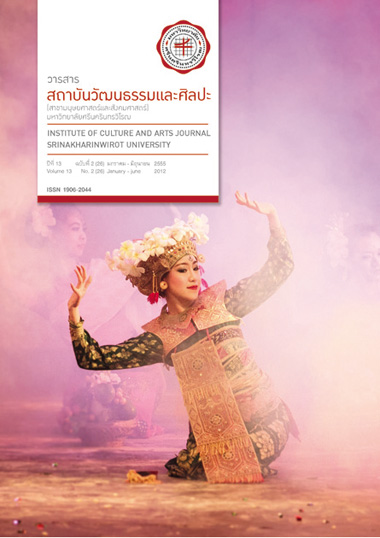ฟ้อนผีมอญของชาวมอญบ้านหนองดู่และบ้านบ่อคาว ตำบลบ้านเรือน อำเภอป่าซาง จังหวัดลำพูน
บทคัดย่อ
MON GHOST DANCE RITUAL OF BAN NONG DU AND BAN BOR KAW COMMUNITIES, BAN RUAN SUBDISTRICT, PASANG DISTRICT, LAMPHUN PROVINCE
บทคัดย่อ
พิธีกรรมฟ้อนผีมอญของชาวมอญบ้านหนองดู่และบ้านบ่อคาว ต.บ้านเรือน อ.ป่าซาง จ.ลำพูน เป็นผลจากความเชื่อและความศรัทธาในผีบรรพบุรุษ มีการทำพิธี ในเดือนมีนาคมถึงก่อนวันเข้าพรรษา ห้ามทำในวันพระ วันพุธ และวันอัปมงคลตามปฏิทิน การทำพิธีแบ่งเป็นสองวันคือวันเตรียมหรือวันดา เพื่อสร้างปะรำ ทำเครื่องเซ่นไหว้ และวันประกอบพิธี ซึ่งมีแบบครึ่งวันกับแบบเต็มวัน ช่วงเช้ามี 9 ขั้น คือ ยกขันครู ถวายขันผีปู่ย่า รำดาบ ปัดพยาธิ ตัดต้นกล้วย นำผู้ป่วยไปอาบน้ำ แต่งตัวให้ผู้ป่วย เรียกวิญญาณ และดูขาไก่ ช่วงบ่ายมี 15 ขั้นคือ ผีกุลา ป้อนข้าว เล่นผีนาง ทั้งสองทั้งสาม เล่นผีนางน้อย คาบปลา ปู่ย่าขึ้นหอ เล่นน้ำ สงกรานต์ ชนไก่ เอาผีขันโตก ไปไร่ คล้องช้าง จุดกระบอกไฟ ดูหยอดน้ำตาเทียน ถ่อเรือ และถอนต้นแก้ว การฟ้อนในพิธีฟ้อนผีมอญนี้จะมี 2 แบบคือ 1. แบบที่ โต่ง(ผู้ดำเนินพิธี) เป็นผู้ฟ้อนแต่เพียงผู้เดียว โดยโต่งจะเริ่มฟ้อนตั้งแต่พิธียกขันครูจนถึงปัดพยาธิ และ2. แบบที่ลูกผีช่างฟ้อนและลูกผีปู่ย่าร่วมฟ้อนด้วย โดยเริ่มตั้งแต่ขั้นตัดต้นกล้วยในช่วงเช้า จนกระทั่งขั้นสุดท้ายคือถอนต้นดอกแก้ว ส่วนท่าฟ้อนจะมี 2 แบบ คือแบบฟ้อนดาบซึ่งท่าฟ้อนจะได้รับการถ่ายทอดจากโต่งคนก่อน และแบบฟ้อนมือ ซึ่งจะไม่มีท่าแบบแผนและท่าตายไม่เน้นความสวยงาม ไม่มีความหมาย จังหวะมีทั้งช้าและเร็ว เพลงที่บรรเลงเป็นเพลงพื้นเมืองภาคเหนือ เพลงไทยเดิมประยุกต์ และเพลงลูกทุ่ง
คำสำคัญ : ผีบรรพบุรุษ ฟ้อนผีมอญ มอญ
Abstract
Mon Ghost dance of Ban Nong Du and Ban Bor Kaw, Ban Ruen subdistrict, Pasang district, Lam Phun province was based on the believe of ancestors spirits. The spirit related ceremony have to be carried out between March and June before Buddhist lantern day except Buddhist day Wednesday and other so called “inauspicious days” on calendar. The ceremony takes two days. The first preparation day called “Wan Triam” or “Wan da” is when stage for ceremony is built, food and other sweets to offer to spirits are prepared. The second day is ceremony day. The ceremony day can be full day or half day. The first half of ceremony day consists of 9 parts as followings : Yok Kan Kruu, Tawai Kan Phee Pu Ya, Ram Dab, Pad Payad, Tud Ton Kroy, Abb Nam Pu Puy, Tang Tua Pu Puy, Reak Winyarn, and Du Ka Kai Afternoon ceremony consists of 15 parts -Phee Kula, Porn Kao, Len Phee Nang Tang Song Tang Sarm (play with Nang Tang Song Tang Sarm ghosts), Len Phee Nang Noi (act as Nang Noi ghost), Karb Pla, Pu Ya Kun Hor, Len Songkran (throwing of water), Chon Kai, Ouo Phee Kan Tok, Pai Rai, Klong Chang, Jud Kra Bok Fai, Du Namta Tien, Tor Ruer and Torn Ton Keaw. There are two types of dance : 1. Tong is only one dancing. Tong begins dancing from Yok Kan Kruu to Pad Payad and 2. Luk Phee (dancer team) and Luk Phee Pu Ya (ancestor of sprit family) dance with Tong. The dance has no set movements. There are two types of dance. One is the sword dance, which is inherited from 36 the former. Another one is using hand position, which were not designed to be graceful or beautiful, no particular meaning, consisting fast slow or comical movements according to the music which are not necessarily Mon music but could be Thai classical, arranged Thai classical or country music.
Keywords : Ancestors spirits, Mon, Mon Ghost dance
Downloads
ดาวน์โหลด
รูปแบบการอ้างอิง
ฉบับ
ประเภทบทความ
สัญญาอนุญาต
บทความทุกบทความที่ได้รับการตีพิมพ์ถือเป็นลิขสิทธิ์ของวารสารสถาบันวัฒนธรรมและศิลปะ มหาวิทยาลัยศรีนครินทรวิโรฒ



